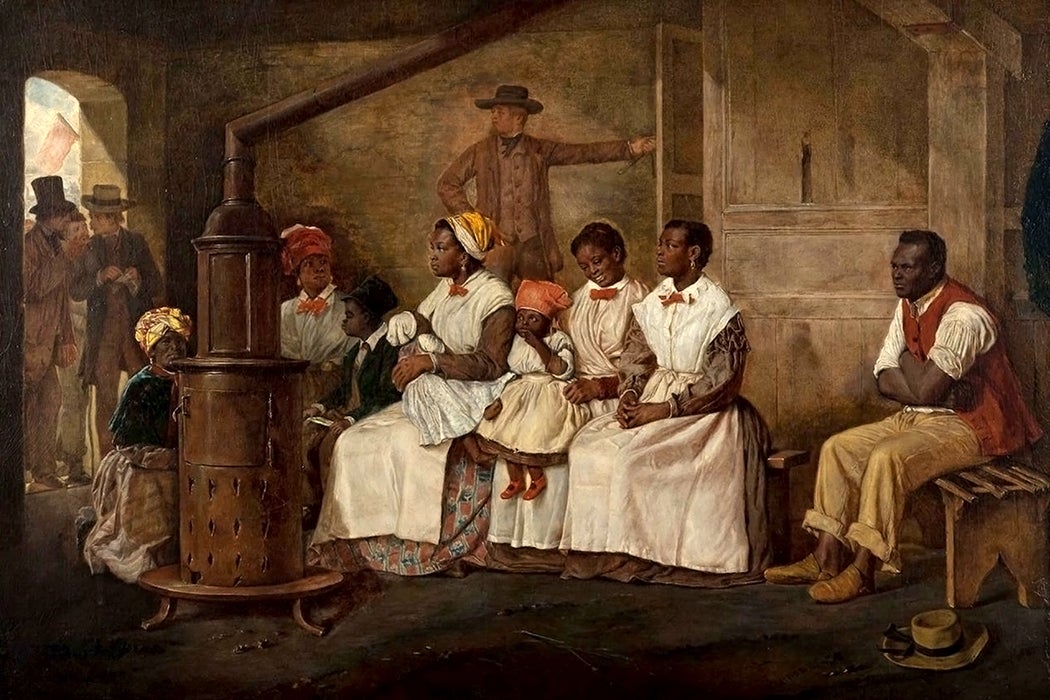Slavery in the United States is usually thought of as a form of coerced labor, especially in agriculture, where the enslaved produced such economically important crops as cotton, rice, and tobacco. The enslaved also powered trades like construction and blacksmithing and served as the literal backbone of domestic work. But this focus on labor obscures the fact that slavery also represented enormous wealth that was extraordinarily liquid: an enslaved person represented cash that could be forced to work, forced to breed, forced to relocate.
What scholars Felipe González, Guillermo Marshall, and Suresh Naidu describe as slavery’s “sophisticated system of property rights and financial contracts” was fundamental to “American economy development.” In this light, the coming of emancipation and then abolition by way of the Civil War was “one of the largest destructions of wealth in US history.”
Enslaved people “were financial assets,” they write, “readily sold on ubiquitous auction markets, pledged as collateral for loans, and used to settle payments and debts over long distances.”
In fact, these scholars show, slave wealth “allowed access to finance on better terms than real estate or other major types of wealth present in the antebellum Southern economy, facilitating business startup.” Slavery thus provided a “credit market advantage,” a form of collateral better than most anything else which gave slavers a distinct advantage in business formation, or what is often now called entrepreneurship.
“Chains of credit linked Mississippi planters to cotton factors in New Orleans, who in turn relied on credit from New York bankers and Liverpool merchants,” explain González et al. The liquidity of slave property also supported other financial instruments like mortgages, insurance contracts, and warranties.
All this wealth translated into political power, both locally and nationally. In González et al.’s case study of slavery-financed business start-ups in Maryland during the Civil War, they found that southern Maryland’s rural slave-owners dominated the state’s politics while “the northern part of the state was urban, industrial and overwhelmingly free.” Slave-owners could do so because Maryland’s state legislature apportionment was determined by population, including the enslaved (who were counted as full citizens though they had no right to vote; compare with the three-fifths citizens of the US Constitution). For tax purposes, Maryland’s political elite had the enslaved capped at $400 a head in valuation, “giving a tax advantage to slave assets relative to land and other forms of property.” (In 1860, the price of a twenty-five-year-old enslaved male in Maryland averaged $1,350.)
By 1858, slavery in Maryland was more about “production for the southern market,” as a writer for the Frederick Examiner put it, than for local agricultural labor. Selling an enslaved person further south was much more lucrative than using one on a Maryland farm. The hiring out of an enslaved laborer was also ubiquitous and profitable.
“Slave ownership did not necessarily force one to engage in slave-intensive activities,” write González, Marshall, and Naidu. “Instead, one could pledge a slave as collateral for loan, use the loan to start a business that did not use slave labor, and then rent out the slave for additional income.”
Weekly Newsletter
Such “thick rental and resale markets could facilitate a wide variety of business activities potentially far removed from slave labor” itself. Even in Baltimore, where only one percent of the population owned slaves, slave-ownership had an advantage when it came to starting businesses over non-slave owners.
As a border state, Maryland wasn’t covered by the Emancipation Proclamation. Though the state stayed with the Union, it was decidedly anti-abolition, voting less than 5 percent for Lincoln in 1860 and rejecting a compensated emancipation plan in 1862. Slavery was finally outlawed by a new state constitution in 1864, which was ratified with less than a one-percent margin (thanks to Maryland’s Union soldiers, who voted overwhelmingly for it). Additionally, a few months before this vote, the War Department had opened enlistment to the enslaved Americans in the state, and emancipated those who did so. The walking parts of the financial system walked away from the monstrosity of the system.







